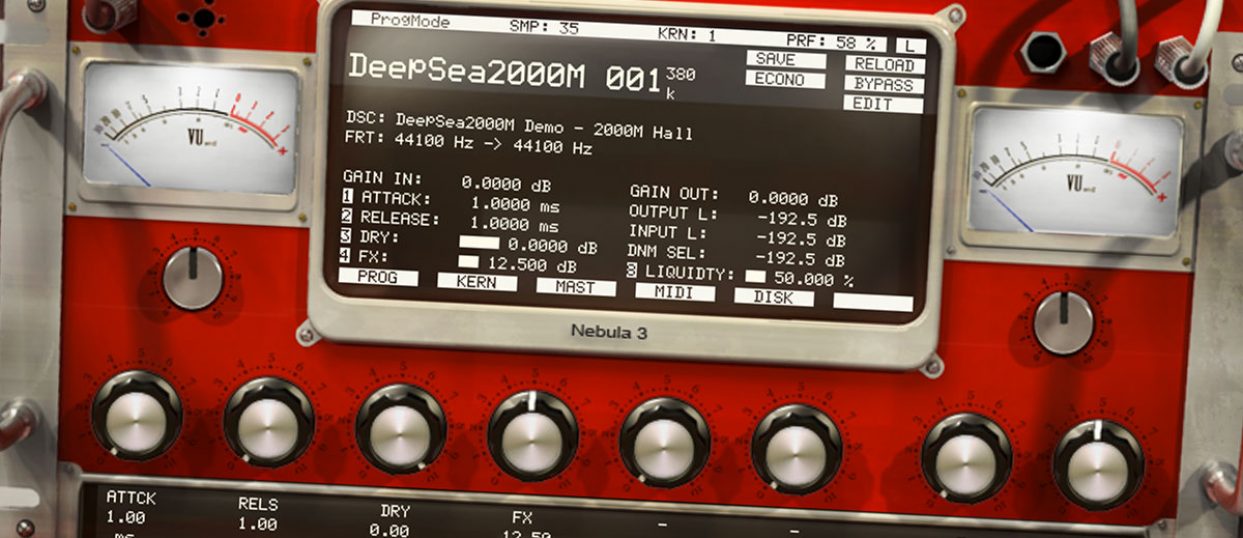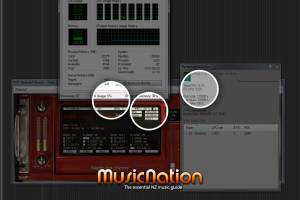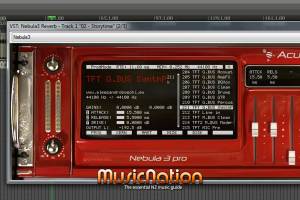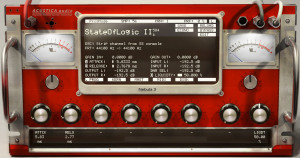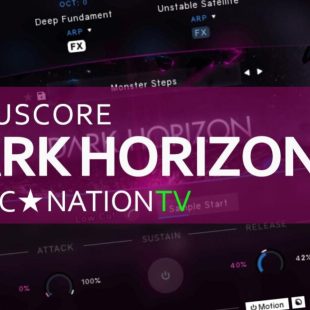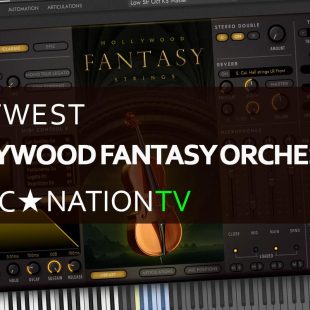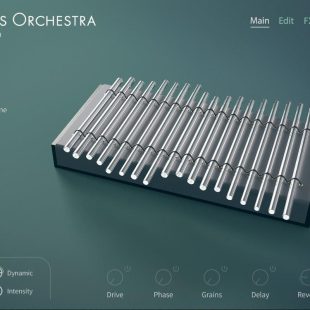Acustica Nebula 3 – The hardware holy grail?
Acustica Audio Nebula 3 effect sampler VST plugin review
Hey guys, welcome back to StudioWise – today we’re checking out Nebula 3 by Acustica Audio. This is the longest I have spent reviewing a product, just learning some of the finer intricacies of the software – It’s been a strange journey, to say the least.
Nebula has been around for some time now, touted as the new revolution in computer audio and the death of studio hardware (more so by its ardent user community than the developers). At its core operation, Nebula3 is a multi-effect unit that uses impulses instead of more traditional digital calculations to reproduce effects, but it doesn’t use the standard convolution impulses you might be familiar with. Nebula has its own proprietary format called Volterra Kernel Sampling (VKS), which is like convolution impulses on steroids. The practical difference for the end user is way more dynamic results when playing different amplitude signals. The results can often be subtle, but still noticeable – what Acustica Audio calls ‘3D sound’.
It’s what’s under the hood that really matters
So Nebula is tricky in that it can playback impulse responses based on the input level, delivering much more realistic results. Think of the impulses being in layers ranging from quietest to loudest, much like a sampled piano has velocity layers. The harder to strike the piano key the higher up the order of loudness the piano plays the note. The other interesting difference between this and other lesser brethren is Nebula3 has its own audio engine that allows, amongst other things, samples to be affected by LFOs, envelope filters, ADSR and a whole range of modulating effects to truly create some new and interesting effects.
In its simplest operation mode you don’t need to be too worried about all the technical stuff behind the scenes, just choose a preset and see if you like it. It’s a very hit-and-miss approach. Unlike a normal VST plugin, Nebula3 interface changes for whatever you load into it – be it an EQ patch, reverb, compressor etc. Some presets have many controls, others none at all. It all depends on how the developer of the sample bank has set up the patch. There are some very advanced controls that allow you to squeeze the maximum quality out of your patch but be prepared for some serious research if you plan to dig deeper.
Patches are split into categories of PRE (preamps), REV (reverbs, )EQU (equalizer), COM (compressor) and the likes, and there are a lot of patches to play with in the factory bundle.
A bit of geek stuff
In a nutshell, a standard convolution impulse is a sample recording taken by shooting a test tone (impulse) into a device, room or space – a process called Brute Force Sampling. The resulting recording has the test tone removed and the remaining signal is the impulse. This can be applied to other audio signals to emulate the effect, as opposed to traditional effects that use digital calculations to create synthetic emulations. This process is a lot more CPU intensive, but as computers get faster this is becoming less of an issue. One of the main drawbacks of this type of recording is it presumes all signals fed into the impulse player will be at the same dynamic level as the original test tone. This is where Nebula3 changes everything.
Nebula’s VKS works in a similar fashion, except it can read test tones recorded at many volume levels, allowing a lot more information about the recording than a standard convolution impulse would. A test tone recorded for Nebula normally consists of a sine wave that sweeps the full audio spectrum. Nebula’s internal engine can also estimate the gaps in the digital samples, further smoothing out the result and allowing higher fidelity at reasonable CPU costs. But don’t be mistaken, Nebula VKS-based impulse responses require a lot more processing than the standard convolution impulses, and depending on the subject that has been sampled, not necessarily for very noticeable gains. Even a single instance of a high-end reverb patch could max out a fairly serious PC. Fortunately, Nebula’s kernel engine allows users to adjust a number of power requirements to tailor the plugin for the job at hand, allowing user-defined latency.
The obvious benefits are with large reverbs, as a room responds very differently depending on the sound (a whisper vs a gunshot produces totally different characteristics of course). The other interesting result is some hardware devices can be more accurately recorded, as their sound is dependent on the input signal – like a compressor for instance. VKS allows the subtle harmonic nuance of an analogue device to be captured and reproduced in near perfection.
Kernels, timed and frequency domain, oh my.
Nebula operates similarly to a synth engine, in that it has a dynamic section with LFOs and envelopes, plus a building blocks section called kernels. The manual compares kernels to polyphony on a keyboard, which is a good analogy. Generally speaking, the more kernels a sound has, the more complex the sound it generates will be, but the more CPU resources it will require.
Nebula3 has 2 kernel playback engines, and it allows you to swap between – Timed Domain and Frequency Domain (Called TIMED and FREQD). The timed Domain used a lot more CPU cycles than Frequency Domain, but the quality is a bit higher. Swapping between the two allows you to choose between the more intensive CPU option if required. You can also change the amount of time the kernel is in use before it swaps to the other, so, for instance, you can have the effect in Timed Domain for the initial attack, and use Frequency for the tail where quality might not be as important.
On our test machine, there were few noticeable differences between sound and processing power, but once you start loading up more instances I can see this being a valuable tool. Out of the box, you won’t need to mess with the kernels much, however, if you like you can open the ‘KERN’ page and have a play. The internal synth engine is also editable by clicking the EDIT button on the main program screen. In here there are a bunch of typical controls for editing parameters and creating special effects.
Right, let’s get the bad out of the way…and there’s some bad.
Nebula3 is a powerful effect engine, no doubt – but there are a few frustrating design issues you will need to battle through to master this device.
Nebula3 employs a tiny faux LCD ‘touch screen’ that employs a confusing myriad of acronyms, strange labels, legacy controls and – quite possibly the dumbest idea I’ve ever seen in a VST plugin – slider-controlled numeric input for parameters (remember way back in the ’80s, all the synths used to have sliders to change numbers or letters).
Everything has a sort of DOS 3.0 vibe, and the limitation of characters for important controls is annoying. For instance, they labelled the important ‘Rate’ indicator ‘RTE’. Why an extra ‘A’ couldn’t be added in the design stage to make it easier to read is beyond me.
Some of the controls are backward too, so for instance, if you choose bypass mode, you’re actually in process mode and vice versa. Stereo, you’re in mono, econo you’re in normal etc, you get the picture.
We didn’t find the metering to be as useful as it could, considering the importance of delivering correct gain into Nebula, we wished the metering was better. We need to use a 3rd party plugin (the excellent Sleeytime Audio stereo channel) to accurately judge the levels. You have the choice of a digital readout or a single 12-segment LED style single input gain and another for output, which for us is way too simplistic for accurate gain judgment.
There is an issue with how Nebula reports performance figures to your DAW, so you cannot rely on figures put out by your sequencer as being accurate. You need to allow a little bit more CPU power than you think for Nebula to play nice – in our testing between 5-10% to be safe.
Mono vs Stereo modes is not what you think either – Mono (or Mono-L as it’s labeled) actually means stereo internal processing, whereas stereo means split left and right stereo internal processing(!!). And as mentioned before, if it says you’re in MONO-L mode, you’re actually in Stereo mode.
On some presets (like preamps) you get attack and release as your main slider controls, presumably akin to compressor controls – but no, attack and release are used for the internal envelope follower, they are available for troubleshooting in case of crackles.
The preset browser gives you the choice (by clicking either a tiny ‘L’ or a ‘V’ – which I still have no idea what they mean) of either a menu drop-down style list of presets, or an in-screen collection of all the presets in number order, but the numbers don’t seem to have any relevance to anything in particular – I think they are just randomly assigned to patches. The numeric option is horrible, as there is no way I could find to search or even scroll through the presets easily. The drop-down menu option is also frustrating as you need to click down through menu after the menu after the sub-menu any time you want to change a preset. There is a ‘recently used’ section on the menu, but it only works as long as you have the plugin open. If you close and reopen again, you’ve lost everything.
I’m not sure why everything needs to be so difficult to operate – It’s like the designers have purposely tried to make Nebula3 as difficult to use as possible, short of writing everything in Russian, I’m not sure it could get worse. Due to the nature of the patches you load, you literally need to refer to the manual for every single operation, and even then you’re never quite sure what is going on, it’s all a lot of trial and error. As mentioned earlier in this review, we have spent over a week now researching and learning the basics, but there is still a fair amount of head-scratching with some of the functions.
From the developers
The interface is inspired by the Kurzweil K2000. At first, the goal was to cut development time, in fact, it was much easier to create an interface of this type as if it was really a hardware synthesizer. The interface is likely to change over time, but the users seem to like everything. There are 3 positive effects:
– It discourages the editing of the parameters;
– The users feel they make an investment to learn how to use it and this puts them on a different level than the others. A simpler product would have risked a to be sold to a mass-market, with sales apparently higher. With a complicated interface, we have removed a category of users that would then seriously have problems with everything else. A difficult interface is a filter;
– For the mass market: we have developed the Acqua Plug-Ins family, objects that are easy to understand and to use.
Ok, rant complete, where’s the silver lining?
You know the biggest problem with Nebula after all is said and done….it’s bloody brilliant. It really is.
It would be too easy to just write this off after playing with it for a few minutes, but after some time invested, you soon discover Nebula3 sounds good – really good. So good in fact I totally forget how bad the interface it. I forget how terrible the documentation is, and forget the hours and hours I spent trolling the internet and user forums for help and advice. After listening to a few examples of it in action, there is no way you can go back to standard convolution impulse players again. Nebula3 is a real credit to the amazing VKS engine, it is capable of producing by far the best computer-based effects I have heard (and we get a lot of stuff through the Music Nation office)
As mentioned before, Nebula3 uses impulse responses captured from real-life hardware devices (which in itself I can see having some fairly dubious legal issues on the horizon…see below). Nebula3 is in practice, an ‘effect sampler’. We have a couple of the actual hardware originals here in the Music Nation studio that we compared with the Nebula3 samples – and it was near as damn perfect.
How legal is impulse sampling?
We spoke with Tim Farrant from Buzz Audio in Wellington, developers of some of the world’s best hardware units. It really is a grey area, for both sides. Technically speaking, if you record something (sample) and then on-selling it you are breaking the law – no different than recording a movie and then selling it on a website (and you know how fast the movie industry would clamp down on you if you tried that on). None of the 3rd party Nebula preset developers use the actual brand name of the unit they’re sampling (presumably because they haven’t asked permission to do so), but you don’t need to dig too deep to discover where they got the samples from, often having slightly altered names and photos of the original hardware units.
Of course, none of the hardware developers is massive corporations, they will never have the resources to police anything like this, but the general feeling is if you’re sampling your own device for personnel use, fine – but to profit from sampling devices is pretty close to stealing (why would you ever buy the expensive hardware when you can get the sample which has been recorded from that same hardware unit for pennies).
The general consensus we found in the community is ‘Well everyone else is doing it, so it must be ok’. Most people seem to be indifferent, but it will be a shame when the software finally destroys the hardware industry and we have no new hardware equipment left to sample.
Conclusion
So with all this said and done, Nebula is not for the faint-hearted. You will need some serious time available to learn the ropes. Is it worth the effort? For sonic quality, I’ve not heard anything that comes close short of the real hardware. The interface is pretty bad, but not unforgivable. With some time spent you could make up a fairly effective workflow to speed up the process (pre-applying preamp effects to audio tracks, creating template FX chains etc. You can even edit the core XML files with Notepad to really fine-tune your setup).
At $220 (NZD), it’s expensive. And to add salt to the wound, the supplied impulses are mostly fairly average – and pretty much anyone you run into on the forums will tell you -‘oh yeah, don’t use that – download the ‘XYZ’ bundle, its amazing.’ The problem is each of these 3rd party bundles can add $50-$80 extra to your credit card statement. Can I rate Nebula 3 highly? Not in good conscious, no – however there is no doubt the sound quality is unmatched. Nothing we have seen short of the actual hardware comes even close, and even then Nebula 3 offers the flexibility of software in that you can apply multiple instances of the plugin across your mix.
Amazing technology, which will only get better over time as the software is developed more and the 3rd party patch vendors grow. Hardware killer? Not yet, but not far off either. The writing might be on the wall for hardware manufacturers, but I hope with isn’t the beginning of the end for our beloved studio candy.
www.facebook.com/AcusticaAudio
TamingThe Beast
We were very fortunate to stumble upon David from Learn Digital Audio (www.learndigitalaudio.com), which is an amazing website packed full of plenty of Nebula advice and tips, plus a full-on audio course available to help you understand Nebula and various other associated principles required to have a full understanding of the process in which Nebula works. There are two-course variations (starter and pro), and both are on sale right now so it’s a great time to check them out.
We were pretty lost, to begin with, and thanks to David’s easy-paced tuition a few lights went on in our heads a lot sooner than if we just relied on the manual. If you are new to Nebula, consider this required cost of access – it will save you many days if not weeks of researching and second-guessing.
Check out our hands-on demonstration of Nebula3 in action
And a full studio mix demonstration using Nebula3

